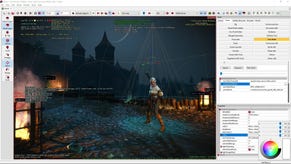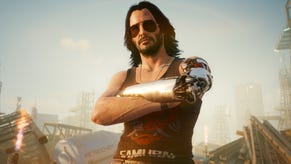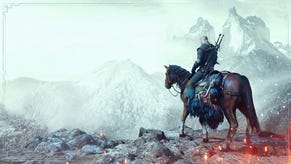When Previews Attack: Revisiting My First Impressions Of The Witcher 3
Critical Distance
On The Witcher 3 [official site], preview events and getting it wrong.
Before I'd played it, I thought The Witcher 3 might turn out to be a disaster. I wrote about my apprehension, attempting to explain that everything I'd seen looked extremely pretty but that I felt only the surface had been shown. There might well have been a glorious game beneath the surface, I was keen to stress, but I hadn't seen enough evidence to describe let alone praise that game.
I was wrong, as everybody now knows, and what a wonderful feeling it IS to be wrong in a situation like that. Previews are tricky things to write because most games can't be judged as incomplete fragments. We're asked to devour videos, presentations, vertical slices, unfinished code and short hands-on sessions, and we talk to developers who are usually talented and passionate. It's natural, as a critic, to counterbalance the promises made and potential seen with a healthy dose of pragmatism.
Usually, I try to cut through the guesswork and claims to identify what I've actually seen or played. That's not always possible or useful though. If I see a combat system or crafting mechanic, there will be some speculation involved as to how exactly those things will work over the course of an entire game. What are the specific rules and how much variety is likely across the thirty, forty or sixty hours I'll spend with the game.
It's easy to fall into all kinds of traps when speculating – if some aspects of a game are recognisable, as is almost always the case, it's tempting to speculate that they function exactly as they do in other similar games. Because so many games fit the formula A meets B with a mechanic from C, critics often recite their ABCs without fully recognising the words that the letters spell out.
And so it was with The Witcher 3 preview I wrote almost a year ago. I saw a pinch of A, a pile of B and a complete lack of D, so I wrote about my concerns and a lot of people thought I was being a total C. Now that the game has stolen my heart, I'm going to pick out parts of that preview so that we can all remember how WRONG I was.
---
Whether The Witcher 3 achieves its loftier goals or not, it will almost certainly serve to spoil the cluster of buildings that often constitute the capital city of a digital fantasy kingdom. Novigrad, the largest city in the game, is enormous. Geralt arrives on horseback and rides by the docks, where boats ply their trade and the cry of the fishmongers can be heard (thanks, Fink).
The scale of the environment is staggering and the NPCs that inhabit it apparently have their own schedules and behaviours. People spend the day going about their business, whatever it might be, and when night falls, they head home or to taverns. It’s a living city, at least to some extent, although the visible interactions with the populace either involve nudging them aside, like an Assassin, or receiving quests from them.
Well well well. I wasn't wrong at all! The scale of the urban environments is one of my favourite things about The Witcher 3. The inhabitants of those places aren't as unique as I'd hoped but I have no argument with the sense of place.
Outside the city, Geralt performs parkour as he scrambles across cliffsides and searches for alternate routes to his objectives. He’s able to use his witchy (witchery?) senses to track and hunt, overlaying glowing red foot and claw marks onto the terrain. When he finds his prey, combat is violent, fast and fluid, with special abilities interrupting enemy attacks and tipping the advantage in his favour.
I was overly kind to the combat! It's violent and fast, but it's not as fluid as it looked in the developer walkthrough.
The presentation’s forty-five minutes involve what feels like forty-seven minutes of dialogue, much of it delivered in a lovely soup of regional British accents. It’s all a bit daft, as tales of swords, destinies and corsets tend to be, but even when a godling called Jonny (Dobby the house elf cosplaying as Gollum) provides some light relief among he grim and the grit, the script seems to be almost entirely earnest.
Sample lines – “Do you have bollocks?” and “You need a knight-errant or a witch hunter, not a witcher.” I mentioned that line to Graham, unaware of the distinction between a witch, one who witches and a witch hunter. He suggested witchers might have unionised their slaying, creating a division between them and the strike-busting witch hunters. Seems likely.
Here I was wrong. The Witcher 3 surprised me in many ways but the characters, dialogue and voice acting were the biggest surprise of all. I like Geralt's weariness and the complications of the world. It's a place I enjoy spending time full of people that I enjoy spending time with. I still maintain that the section shown was a poor example of that but I was far too dismissive. That comes at least in part from having skipped the first two games, after playing for a few hours each, and having no connection to the world or characters through the novels or anything else.
My occasional aversion to fantasy lore aside, there’s a pleasing fairytale quality to Geralt’s hunts. He’s not punching orcs, he’s seeking half-forgotten creatures and dangerous rumours. Rumours with teeth and a bulbous eyes. And he’s doing it in one of the most beautifully detailed environments I’ve ever seen. It’s stunning to look at, both in terms of its preposterous scale and the intricacy of every texture, tree and living thing. It’s a place that I want to spend time in but, despite the open world claims, on the evidence of this short visit it’s a place in which time is spent listening to instructions, following quest markers and hitting things until they die.
There are alternate routes to find, I’ve seen that with my own eyes, but the destination has always been a verbose quest-giver or an angry monster. There’s no single moment, outside the city walls, that makes the extravagant world seem like more than a backdrop for a series of encounters. The order they occur in will vary as players explore as they see fit rather than being pushed in a specific direction but despite the beauty of the place, it may not contain as much surprise, improvisation and mystery as the most convincing fictional spaces.
Here's the biggest misreading on my part (or miscommunication on CDProjekt's part). I'm glad that I picked up on the folklore aspect of questing because it's the strongest part of the game. The Witcher 3 throws out fetch quests and replaces them with learning and preparation. What I didn't understand last year was how fundamental a shift that would be.
The Witcher 3's open world isn't necessarily about multiple choices and credible behaviour – it's about encounters and quests that feel like a natural extension of your existence in that world, and that's a revolutionary shift from the disconnected whack-a-moles and rabbit-holes of many open world RPGs.
For one moment, as Geralt traipsed through a swamp, ominous stomping flooded out of CD Projekt’s meaty bass system. Local wildlife, large, we were told. It sounded bloody enormous and didn’t appear to be related to any current quest. And apparently it wasn’t because instead of encountering the source of the sound, or even turning around to look at it, we were plunged into another dialogue-heavy cutscene, at which point the mystery interloper apparently ceased to exist.
Still a frustrating moment. Whether it was an intentional tease that backfired (in my mind at least) or a slight accident, the demonstration had been tightly focused on scripted quest encounters so I was hoping for something a little more dynamic. A wandering beast would have fit the bill and the immediate jump into a conversation – which took Geralt out of the world and into a separate state – highlighted a lack of cohesion between different activities. Conversation was an instance in which that creature no longer existed.
In the game I've been playing for the last couple of months I don't care. Almost everywhere I go, indoors or out, I travel to seamlessly. The Witcher 3 is the RPG I've wanted to play since Daggerfall and the abstractions of its world rarely detract from the remarkable sense of place.
Misinterpreting a game based on video footage is common. It happens all the time, whether the video has been designed to intentionally mislead and disguise or not. What’s rare in the case of The Witcher 3 is how accurate the video was, the excess of the graphics aside, and yet how large the gap between watching and playing turned out to be.
Perhaps it comes down to the fact that wonderful highlight reels and atmospheric sequences can be extracted from The Witcher 3, but none of them can communicate the feeling of existing in that world and enjoying the quiet moments.
More than anything though, previews are an issue of trust. Do I trust that what I'm seeing will translate into an enjoyable experience and that the quality will hold up through the entire duration of the game? Even if I believe the boldest of claims, do I trust that the developers will be able to meet them? The Witcher 3 seemed too good to be true and, in some ways, it still does. In attempting to create something so enormous, so solid and so well-crafted, CD Projekt convinced me that they were selling a fantasy of the wrong kind.
This feature was originally published as part of, and thanks to, The RPS Supporter Program.














